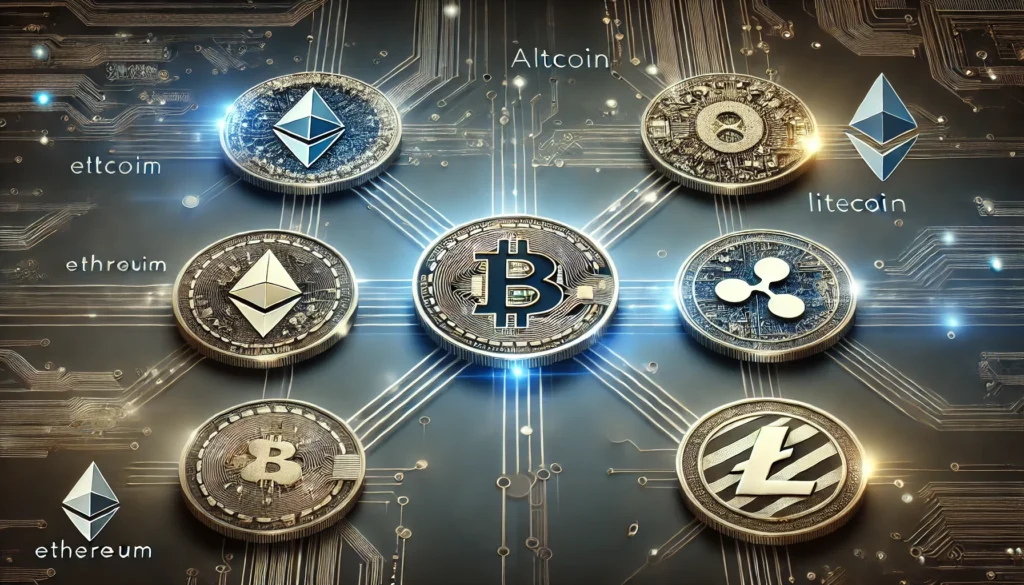Crypto Asset Glossary: Terms and Definitions
The world of crypto is a rapidly evolving space with a unique language and set of concepts. If you’re new to this area, you may find yourself lost among terms like “HODL” or “pump & dump.” But don’t worry! In this guide, we’ll break down common terms you might encounter in the crypto world in a simple, fun, and accessible way. Ready? Let’s dive into the world of crypto!
1. Blockchain

Definition: Blockchain is a secure and transparent digital ledger where data is stored in a decentralized system. Each record (or transaction) is added in blocks, creating a continuously growing chain.
Example: Imagine a group of people sharing a common budget, with each person noting their expenses in a single ledger. However, multiple copies of this ledger exist, and everyone can see all the transactions. Blockchain operates in a similar way but is entirely digital.
2. Cryptocurrency
Definition: Cryptocurrencies are digital or virtual currencies that operate independently of a central authority (like a bank). Most cryptocurrencies rely on cryptography for security and are built on blockchain technology.
Example: Bitcoin (BTC) is the most well-known cryptocurrency. Instead of banks or governments, Bitcoin transactions are verified and recorded on the blockchain.
3. Bitcoin (BTC)
Definition: Bitcoin is the first cryptocurrency, created in 2009 by an individual (or group) under the pseudonym Satoshi Nakamoto. It’s decentralized and is often referred to as “digital gold.”
Tip: Many consider Bitcoin the starting point of the crypto world. Today, it remains the most valuable and widely recognized cryptocurrency.
4. Altcoin

Definition: Altcoin is a term for any cryptocurrency other than Bitcoin. Ethereum (ETH), Ripple (XRP), and Litecoin (LTC) are popular examples of altcoins.
Tip: Each altcoin generally serves a unique purpose or aims to improve upon Bitcoin’s limitations. This is why hundreds of different altcoins exist in the crypto world!
5. Wallet
Definition: Crypto wallets are software or hardware devices used to store your digital assets. Wallets enable you to send and receive cryptocurrencies.
Example: Unlike a physical wallet, crypto wallets are digital and are protected by private keys. If you lose your private key, you may permanently lose access to the funds in your wallet!
6. Private Key and Public Key
Definition: A private key is a unique password that grants you access to your crypto wallet. A public key is your wallet address, which others can use to send you cryptocurrencies.
Tip: Never share your private key with anyone, as it could compromise the assets in your wallet.
7. HODL
Definition: “HODL” originated from a misspelling of “hold,” but it has since become a popular crypto term. HODLing means holding onto your cryptocurrency for the long term.
Example: Investors HODL to avoid being swayed by short-term market fluctuations, especially with major cryptocurrencies like Bitcoin.
8. Mining

Definition: Mining is the process of verifying transactions on the blockchain and creating new blocks. Miners are rewarded with cryptocurrency for their work.
Tip: Bitcoin mining requires powerful computers and a significant amount of electricity, so it usually requires professional mining equipment.
9. Gas Fee
Definition: Gas fees are small amounts of cryptocurrency you pay to complete transactions on some blockchain networks, like Ethereum. These fees vary depending on network demand.
Example: When transacting on the Ethereum network, you’ll pay a gas fee. Higher demand on the network can lead to higher fees.
10. Pump & Dump
Definition: “Pump & Dump” refers to artificially inflating a cryptocurrency’s price (pump) and then quickly selling it off (dump). Speculative traders often use this tactic.
Warning: Pump & Dump is a manipulative strategy and can be risky for investors. Exercise caution!
11. Smart Contract
Definition: Smart contracts are digital contracts that run on the blockchain, executing automatically when specific conditions are met.
Example: Imagine an insurance policy. When the terms are met (e.g., an accident occurs), a smart contract activates and makes an automatic payment.
12. NFT (Non-Fungible Token)
Definition: NFTs are digital tokens representing unique assets on the blockchain. Each NFT is one-of-a-kind and non-interchangeable, often used for digital art, in-game assets, or collectibles.
Example: NFTs have revolutionized the market by allowing artists to sell their digital creations directly as unique, verifiable items.
13. Stablecoin
Definition: Stablecoins are cryptocurrencies pegged to stable assets like the US Dollar. Their goal is to minimize volatility.
Example: USDT (Tether) is a popular stablecoin, with each USDT typically equal to 1 USD.
14. Whale
Definition: A whale is an investor who holds a large amount of cryptocurrency. Whales can move markets due to the scale of their transactions.
Tip: Whale movements often lead to major market fluctuations.
15. FOMO (Fear of Missing Out)
Definition: FOMO refers to the fear of missing out, a common psychological condition among investors. When prices soar, investors may rush to buy for fear of missing out on gains.
Example: When a cryptocurrency’s price rises rapidly, FOMO can prompt many people to buy in at higher prices.
16. Airdrop
Definition: Airdrop is a process by which crypto projects distribute tokens to certain groups for free, often as a promotional or reward mechanism.
Example: A new project might airdrop free tokens to your wallet, which could potentially increase in value over time.
17. DeFi (Decentralized Finance)
Definition: DeFi stands for decentralized finance. It refers to moving traditional financial services onto the blockchain.
Example: Services like lending, borrowing, insurance, and trading can now be conducted through DeFi protocols.
18. Fork
Definition: A fork is a major update to a blockchain, creating two different versions.
Example: Bitcoin Cash is an example of a fork that split from the original Bitcoin blockchain.
19. Staking
Definition: Staking involves holding a cryptocurrency in your wallet to support the network and earn rewards in return.
Example: On proof-of-stake blockchains like Ethereum 2.0, staking can generate passive income.
20. ICO (Initial Coin Offering)
Definition: An ICO is a fundraising event where a new crypto project sells its tokens to early investors.
Example: Investing early in an ICO can mean buying tokens at a lower price, but ICOs are generally high-risk.















Leave a comment